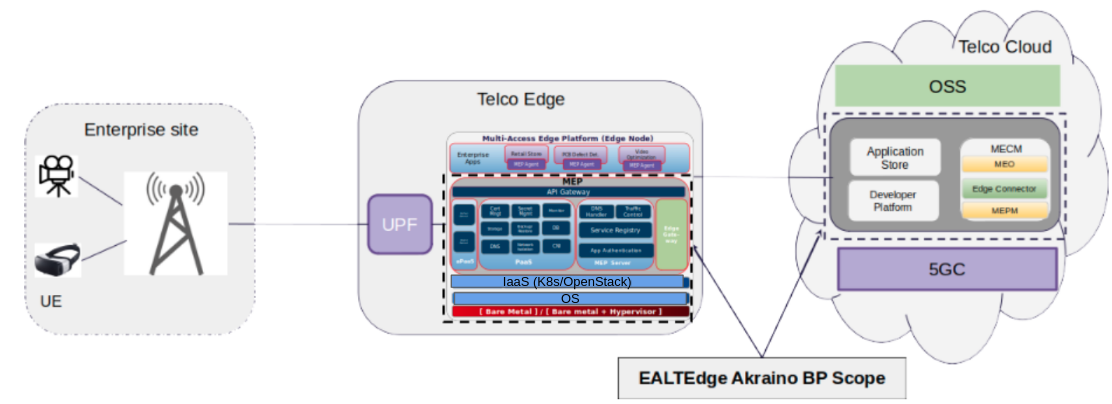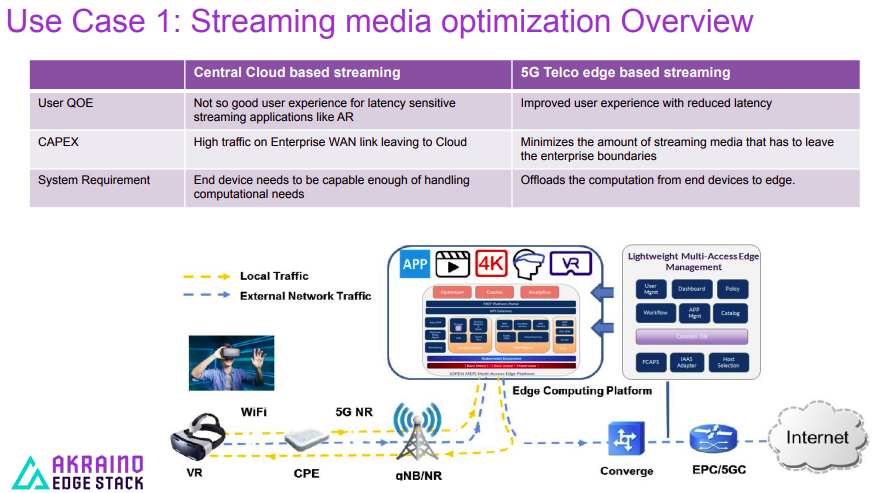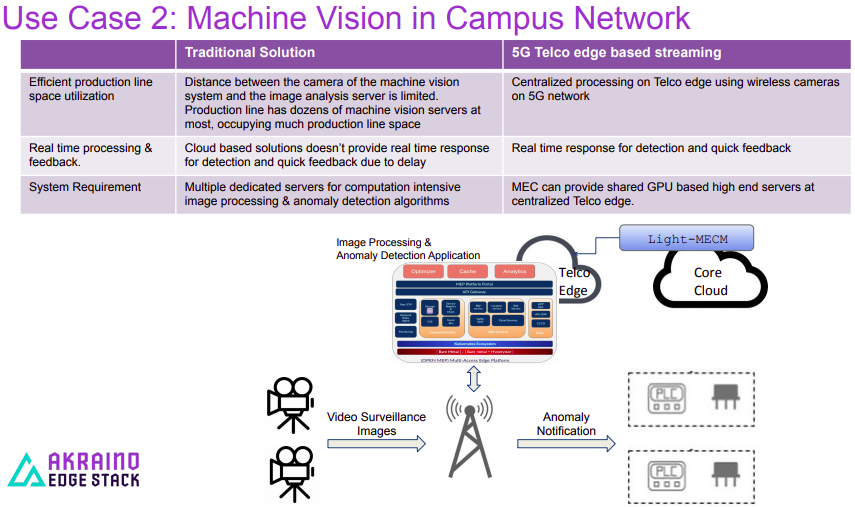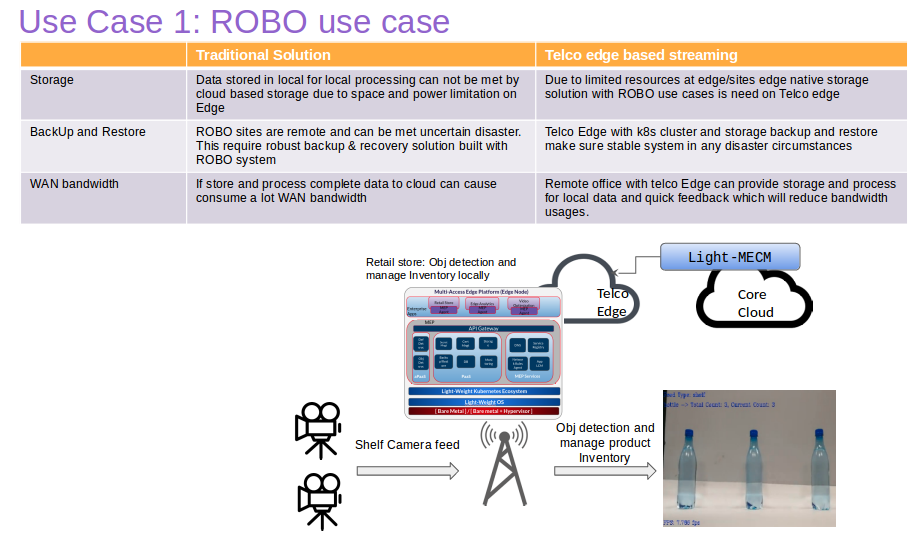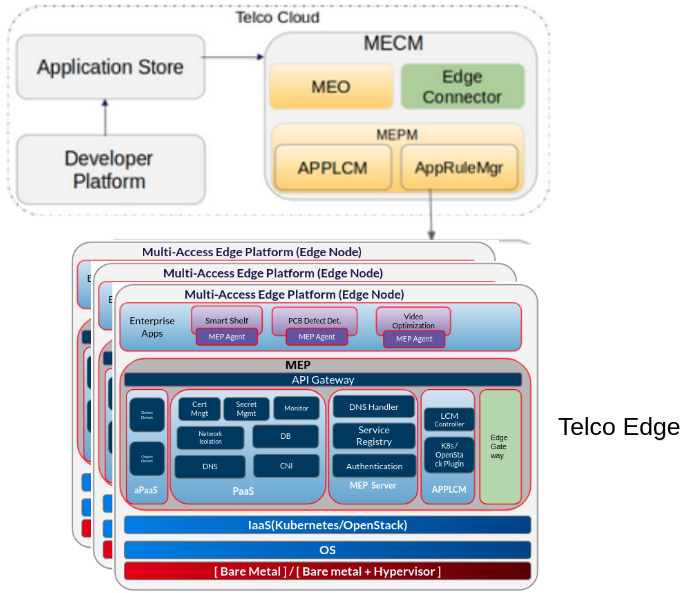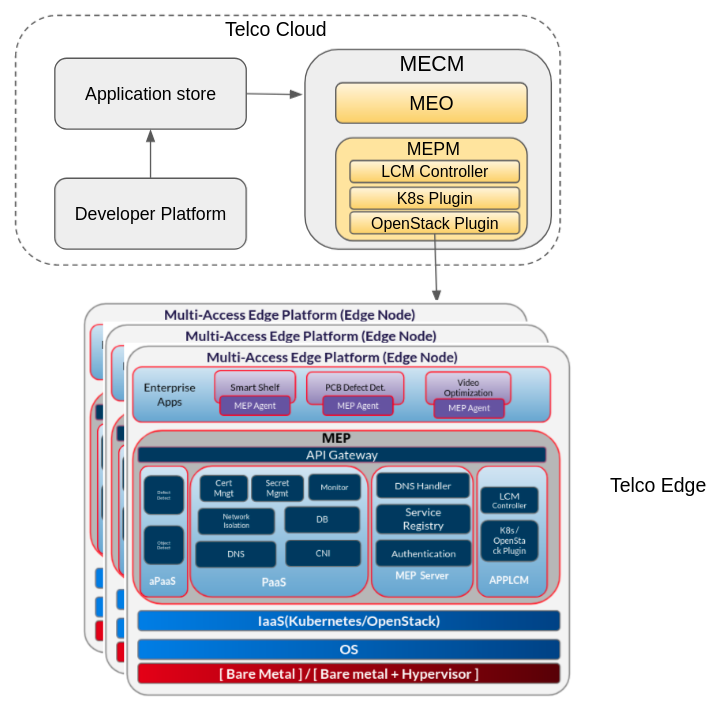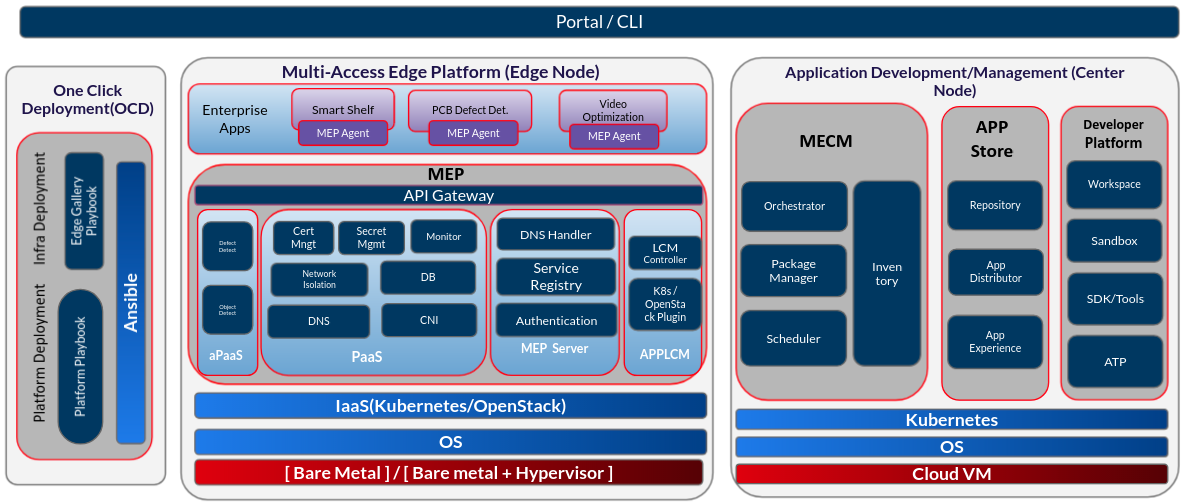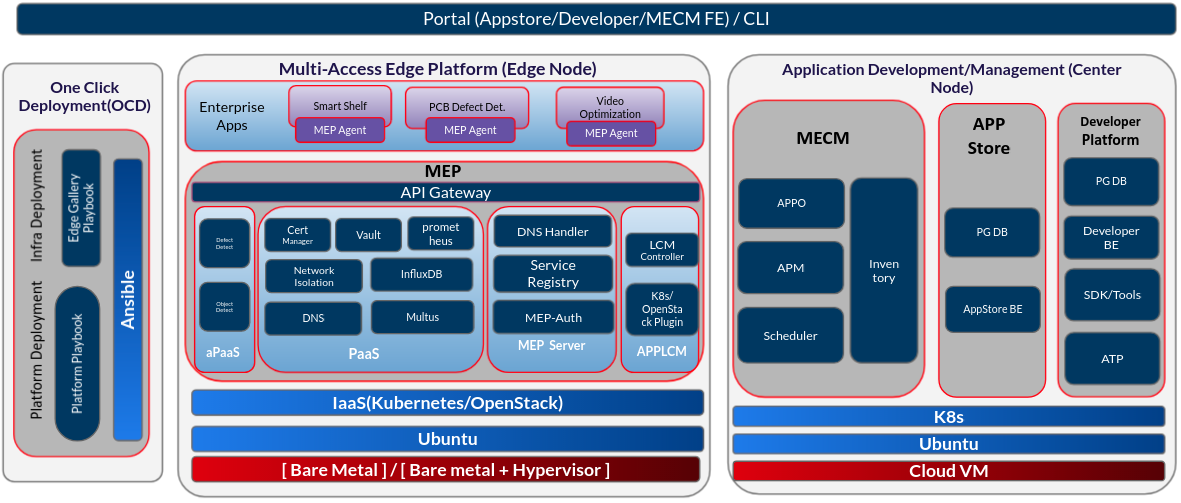Blueprint Overview
Introduction & Purpose of EALTEdge
Enterprise Application on Lightweight 5G Telco Edge is a blueprint under 5G/MEC system blueprint family. It intends to provide a edge computing platform along with application orchestration & management to host enterprise applications on lightweight 5G Telco Edge. Provided edge computing platform and management is meant to be implemented in reference to ETSI MEC (please refer ETSI MEC for further details - https://www.etsi.org/technologies/multi-access-edge-computing) For details kindly refer "Targeted Architecture section". BP also intend to provide platform for enterprise application developers to develop, test, package & onboard their applications easily & quickly, thereby empowering developers to innovate & ship faster. Also eventually BP aims to provide platform capabilities and features like Multi-Tenancy, Network-Isolation, Dynamic Orchestration, Network Capabilities exposure, enhanced identification etc. as needed for "MEC in an Enterprise Setting"
BP plan is to leverage EdgeGallery (http://www.edgegallery.org/) as its upstream project to provide Edge Computing platform, Application Management and platform for application developers. It is also planned to leverage EdgeConnector & EdgeGateway of another BP in same BP family (https://wiki.akraino.org/pages/viewpage.action?pageId=11995699&src=contextnavpagetreemode) to enable features like dynamic & flexible traffic offloading. BP also have plans to add platform capabilities, sample enterprise applications and some features specifically needed for Enterprise use case through new development/integration of other open sources.
The edge computing platform(s) (MEP) needs to be installed at the telco edge(s) and Application development/management related components (MECM (MEO+MEPM+Edge Connector), AppStore, Developer Platform) needs to be installed in Telco's cloud (private/public). Edge computing platform (MEP) provides a platform as a service environment for running "Enterprise Applications" In order to be useful, BP requires 5G RAN & UPF to enable connectivity & have configurations based on use case need. Also 5Gc and OSS system needs to be in place with desired configurations.
Use Case
Diverse types of applications in various enterprise sectors, not limited to below:
● ROBO (Remote office branch office)
● Machine Vision related use cases
● Video Orchestration and Optimization
Use Case 1
Use Case 2
Use Case 3
Architecture
Targeted architecture
Center Node (Located at Telco Cloud)
CENTER Node consists of 3 components. MECM , AppStore and Developer Platform. MEC Manager is the central entity in the MEC system responsible for application and service deployment in an highly distributed computing environment, it provides overall view of hosts and applications deployed in the hosts.
MECM: comprises of MEO, MEPM & Edge Connector which performs the following task
- MEO: Maintains system level view of edges and carries out the Application orchestration to the desired Edge based on Application requirements and Edge node resource availability.
- MEPM: It is MEP manager which carries out application life cycle management and element management for specific Edge(s). There could be a single or multiple instances of MEPM (along with its sub-components) and it could be deployed in cloud or edge depending on deployment needs (like need for Autonomous edges etc.)
- APPLCM
- LCMController: Controls life cycle of applications
- Infra Plugins: Plugin for a specific infrastructure. Objective is to support Kubernetes & Openstack, but architecture would be extensive to add new Infra Manager with plugins.
- AppRuleMgr: Manages Traffic and DNS rules
- Edge Connector: Enable flexible traffic offloading from the aspects of control interaction with mobile network exposed capabilities.
- APPLCM
AppStore: It is like a market place for Application developer to launch their applications.
Developer platform: It is a platform for developer to carry out development and test their applications.
Edge Node (Located at Telco Edge)
Edge Node components manages the execution of various enterprise Applications, it provides various services which can be leveraged by edge applications for smooth functioning and its planned to provide additional aPaas services required for Machine Vision, Video Analytics , IoT Analytics etc in future releases.
Edge Node will comprise of following:
- aPaaS: Producer services for Enterprise applications to consume.
- PaaS: Platform services needed by enterprise application as well as platform components
- MEP Server:
- DNS: DNS server and DNS record management service
- Service Registry: Service registry and discovery, availability notifications
- Traffic Rule Control: Performs traffic rule control
- MEP Services: A mobile edge service is a service provided and consumed either by the mobile edge platform or a mobile edge application like RNI, Location, Bandwidth
- Edge Gateway: Enable the traffic offloading from the aspects of data plane with local traffic routing, traffic management and so on
By leveraging upstream projects like EdgeGallery and In collaboration with other BP in same family "5G MEC/Slice System to Support Cloud Gaming, HD Video and Live Broadcasting" (5G MEC/Slice System to Support Cloud Gaming, HD Video and Live Broadcasting Blueprint - Tentative roadmap of integration other BP is Q2 2022), this BP intends to deliver targeted architecture..
SDO Compliance/Reference
ETSI MEC
BP leverages EdgeGallery as an upstream which follows the reference architecture as defined in "section 6 Reference architecture" of "https://www.etsi.org/deliver/etsi_gs/MEC/001_099/003/02.01.01_60/gs_mec003v020101p.pdf". Following are components which are available/planned
- MEO (Mobile Edge Orchestrator): Mapping to EALTEdge MECM MEO Components
- MEPM (Mobile Edge Platform Manager): Mapping to EALTEdge MECM MEPM Components
- ME app lifecycle mgmt: Mapping to EALTEdge APPLCM component
- ME app rules & reqts mgmt: Mapping to EALTEdge AppRuleMgr component
- MEP
- Service Registry: Mapping to EALTEdge MEP-Server sub module
- DNS Handler: Mapping to EALTEdge MEP-Server sub module
- Traffic Rule Control: Mapping to EALTEdge MEP-Server sub module
EdgeGallery intends to comply with Application Enablement API as defined in ETSI MEC 011 https://www.etsi.org/deliver/etsi_gs/MEC/001_099/011/02.01.01_60/gs_mec011v020101p.pdf & present @ https://forge.etsi.org/rep/mec/gs011-app-enablement-api.
EALTEdge BP will leverage other BP in same BP family "5G MEC/Slice System to Support Cloud Gaming, HD Video and Live Broadcasting Blueprint" for dynamic Traffic routing & steering. Kindly refer that BP for any related SDO references/compliance.
Release 5 Architecture
EdgeGallery in version 1.1 has been added following new features.
- Edge Portal
- Application test platform
- UPF integration framework for DNS redirection and traffic rules configurations
- VM based workload support (Partial)
Details can be found in below EdgeGallery links:
http://docs.edgegallery.org/zh_CN/release-v1.1/Release%20Notes/EdgeGallery_RN_zh.html
http://docs.edgegallery.org/zh_CN/release-v1.0/Release%20Notes/EdgeGallery_RN_zh.html
Smart Shelf application enhancement:
- Enhanced UI
- Notification and Alerts
Below is release 5 architecture for details kindly refer platform architecture section.
Note:
- In release 5 to use BP, Either
- UPF (external entity to this BP) needs to be pre-configured with DNS redirection rules and traffic rules to ensure connectivity.
- UPF integration via UPF adaptor for DNS redirection and traffic rules configurations
SDO Compliance/Reference
ETSI MEC
BP leverages EdgeGallery v1.1 version which deliver implementation referring some part of ETSI MEC reference architecture as defined in "section 6 Reference architecture" of "https://www.etsi.org/deliver/etsi_gs/MEC/001_099/003/02.01.01_60/gs_mec003v020101p.pdf". Following are components which are available as part of release 5
- MEO (Mobile Edge Orchestrator): Mapping to EALTEdge MECM MEO Components
- MEPM (Mobile Edge Platform Manager): Mapping to EALTEdge MECM MEPM Components
- ME app lifecycle mgmt: Mapping to EALTEdge APPLCM component
- MEP
- Service Registry: Mapping to EALTEdge MEP-Server sub module
- DNS Handler: Mapping to EALTEdge MEP-Server sub module
For Application Enablement API compliance details kindly check http://docs.edgegallery.org/zh_CN/release-v1.1/Projects/MEP/MEP_Interfaces.html#mep-server
Platform Architecture
The below diagram gives a overall architecture of the Enterprise Application on Lightweight 5G Telco Edge blueprint as given in Release 5.
Note: EALTEdge Blueprint Deployment has been tested on Cloud VM and is not tested on Bare-Metal Environment. Though, theoretically deployment should work in bare metal, provided hardware and software prerequisites are met. Kindly refer R5 - Test Documentation of Enterprise Applications on Lightweight 5G Telco Edge (EALTEdge) to get details on the tested deployment.
CENTER Components
MECM:
- Portal: The dashboard provides user interface for the MECM services where edge nodes, APPLCM can be registered and apps can be distributed.
- Orchestrator: Provides application orchestration based on static/ dynamic host selection.
- Inventory: Maintains system level view of all Edges, including edge capabilities, deployed applications and their status etc.
- Scheduler: Responsible for selection of host for deployment.
- Package Manager: Maintains and manages application packages and is responsible of pushing images to edges.
- Common DB: Persistent Database.
AppStore:
- Portal: Portal provides the user interface to publish and launch App applications. and has option for user to comment on the application in comment section and give ratings.
- Appstore Services (App Distribution, App Experience): App Store services where uploading an App package and verifies the upload. Also provides features like comment/like for user experience sharing.
- Repository : Open source PostgreSQL database is being used to store the information, Recommended version is 12.3.
Developer Platform:
- Tools: Developer tools are used in Plugin Management, Plugin Life Cycle and grading systems making it more convenient for developers to develop applications and integrate them into the edgegallery platform.
- Workspace: Developers manage their own Application development process by creating projects or migrating projects. Developers can manage project, app package and test task management.
- PG DB: PostgreSQL database version 12.2 is being used.
- Portal: Provides user interface for application developer to interact with developer platform.
- Sandbox: Test environment for application developers to test their applications.
- ATP: application test platform for configure and testing application against set of test cases.
EDGE Node Components:
MEP:
- aPaaS:
- Object Detection Service: This service can be used by developer app for various Object detection for example Bottle detection and count for Retail store inventory.
- PaaS:
- Secret Management: Platform services and developer apps can use this service for sensitive info storing like password, cert etc.
- Cert Management: Platform services and developer apps can use this service for automate certifications management.
- DB: common DB for applications data
- Monitoring: system and apps health monitoring.
- CNI: k8s based networking for multi interface support in a POD for SFC scenarios, network policies etc.
- MEP Server:
- DNS: DNS server and DNS record management service
- Service Registry: Service registry and discovery, availability notifications
- AppLCM: applications life cycle management
- Network Isolation: Provides separation of control, management and data plan
- API Gateway: Provides secure End points for MEP services as well as producer Applications.
- Edge Portal: Portal for autonomous edges.
Software Platform Architecture
The below image shows the software platform distribution and architecture for Release 5.0.
EALTEdge Software Components
CLI: Command Line Interface provides the user interface to install the EALTEdge environment.
CENTER Node -
MECM Services:
- Front End: The MECM-FE management plane mainly provides the registration of edge nodes, APPLCM, and application distribution and deployment functions from the user interface perspective, which is divided into three functional areas. Map area provides switch between nodes in different regions. The KPI, MEP capabilities and application capabilities are displayed in detail according to the currently selected node.
- AppO: Application orchestra tor is the core module responsible for orchestrating life cycle maintenance operation of application. AppO orchestrates application deployment by executing specified process and automated sequence of tasks, rules and policies. AppO is responsible for retrieving the application instance information, edge host performance statistics and edge host platform capabilities.
- Inventory : Responsible for registrations like MEC Host, AppLCM, AppStore, application. Retrieves all the APPLCM records, MEC host records and applications.
- APM: Application package manager responsible for application package management including On boarding, distributing package to edge , retrieves the application package information and download the application package CSAR.
- Postgres DB: Open source PostgreSQL database is being used to store modules specific information.
AppStore:
- Front End: AppStore is a market for developers to publish and launch App applications. Appstore FE provides the registration interface to the new user and once login the store home is visible, where user can upload the application package across various industry domains and displays the list of application along with the details. User has option to comment on the application in comment section and give ratings. Deleting option is also available in "My App/My APP" section.
- Appstore Backend: AppStore is a market for developers to publish and launch App applications. After uploading an App package, it must pass the test first. Only the apps that pass the test can be officially launched.
- Postgres DB: The AppStore database uses an open source PostgreSQL database, and the recommended version is 12.2. Which Stores app information, application package information and review details of the application.
Developer Platform:
- Tools: Developer tools are used in Plugin Management, Plugin Life Cycle and grading systems making it more convenient for developers to develop applications and integrate them into the EdgeGallery platform.
- Workspace: Developers manage their own Application development process by creating projects or migrating projects. Developers can manage project, app package and test task management.
- Postgres DB: PostgreSQL database version 12.x is being used.
- ATP: application testing platform.
EDGE Node Components:
MEP:
- aPaaS:
- Object Detection Service: This service can be used by developer app for various Object detection for example Bottle detection and count for Retail store inventory.
- PaaS:
- Vault: Vault is a tool for securely accessing secrets. A secret is anything that you want to tightly control access to, such as API keys, passwords, certificates, and more. Vault provides a unified interface to any secret while providing tight access control and recording a detailed audit log.
- Cert Management: cert-manager is a native Kubernetes certificate management controller. It can help with issuing certificates from a variety of sources, such as Let’s Encrypt, HashiCorp Vault, Venafi, a simple signing key pair, or self signed. It will ensure certificates are valid and up to date, and attempt to renew certificates at a configured time before expiry.
- Influx DB: Time series data base for user applications data.
- Prometheus Agent: cAdvisor, NodeExporter
- Multus: Support secondary interfaces for PODs in case of SFC scenarios and CNFs
- MEP Server:
- DNS: The MEP platform provides the domain name resolution services to the applications deployed in the EdgeGallery MEC, which can be utilised by the device applications in UE. MEC platform receives the DNS configurations from the MEC management, which includes the FQDN (Fully Qualified Domain Name), IP address and related entries. MEC applications can later query or modify the state of these configurations.
- MEP server: MEP platform services like service registry, discovery, DNS, traffic rules etc. MEP provides service registration, update, delete, and query related API interfaces. Applications can register, update, delete, and query services through MEP. The service registry provides visibility of the services available on the MEC server. It uses the concept of loose coupling of services, providing flexibility in application deployment. In addition, the service registry presents service availability (status of the service) together with the related interfaces and versions. It is used by applications to discover and locate the end-points for the services they require, and to publish their own service end-point for other applications to use. The access to the service registry is controlled (authenticated and authorised).
- Network isolation: Provides separation of control, management and data plane
- AppLCM: LCM controller and K8s/OpenStack plugin. Handles the application life cycle, where lcmController is mainly communicates with K8s/OpenStack plugin to upload config, remove config, instantiate, terminate,and query an application. It also provides APIs to query mep capabilities and kpi information from prometheus.
- KONG: Provides API gateway functionality along with authentication and authorisation.
Below are details of Upstream and Opensource software's used in various nodes of EALTEdge Environment.
OCD Node
S. No. | Software Name | Category | Version Number | Remarks |
|---|---|---|---|---|
| 1. | Ubuntu | OS | 18.04 | |
| 2. | GIT | Version Control | 2.17.1 | |
| 3. | Ansible | Scripting Tool | 2.10.7 | |
| 4. | Python | Scripting Language | 3.6.9 | |
| 5. | pip3 | library of python | 9.0.1 |
CENTER Node
S. No. | Software Name | Category | Version Number | Remarks |
|---|---|---|---|---|
| 1. | Ubuntu | OS | 18.04 | |
| 2. | Kubernetes | Orchestration | 1.18.7 | |
| 3. | Docker | CRI | 18.09+ | |
| 4. | Edge Gallery | MultiAccess Edge Computing Platform | 1.1.1 | Opensource MEC Platform |
EDGE Node
S. No. | Software Name | Category | Version Number | Remarks |
|---|---|---|---|---|
| 1. | Ubuntu | OS | 18.04 | |
| 2. | Docker | CRI | 19.03 | |
| 3. | Edge Gallery | MultiAccess Edge Comuting Platform | 1.1.1 | Opensource MEC Platform |
| 4. | Vault | Secret Management | 0.5.0 | |
| 5. | InfluxDb | Database | 2.0 | Time series data base for user applications data. |
APIs
Please refer the API Documentation link : R5 - API Documentation Enterprise Application on Lightweight 5G Telco Edge (EALTEdge)
Hardware and Software Management
Hardware Management
Currently for this blueprint Huawei Cloud Virtual Machines are being used for development , testing and CD hence there is no specific hardware management to be done.
Software Management
Gerrit Repo : EALT Gerrit Repo
Licensing
GNU/common license
